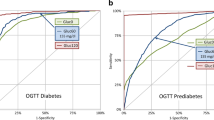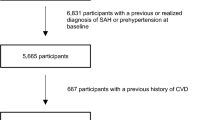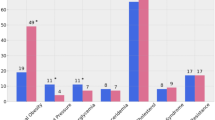Abstract
Objectives: To determine the prevalence of hyperinsulinaemia in non-diabetic hypertensive subjects and to investigate the validity of a simple test for the detection of insulin resistance/hyperinsulinaemia. The test consisted of five markers: (1) obesity (body-mass index, BMI ⩾30 kg/m2); (2) central adiposity (waist-to-hip ratio, WHR ⩾1.00 in men and ⩾0.88 in women); (3) hypertriglyceridaemia (⩾1.70 mmol/l); (4) low high-density lipoprotein (HDL) cholesterol (<1.00 mmol/l in men and <1.20 mmol/l in women); and (5) impaired glucose tolerance according to the who criteria. the test was defined to be positive for subjects who had simultaneously at least two of the five markers.
Design and setting: A community-based screening programme for hypertension carried out at Pieksämäki District Health Centre, and the Community Health Centre of the City of Tampere, Finland.
Subjects: The 161 hypertensives who were detected by screening all subjects aged 36, 41, 46 and 51 years (n = 1148) in Pieksämäki town, and a randomly selected normotensive control group of 177 men and women aged 40 and 45 years in the City of Tampere.
Main outcome measures: Hyperinsulinaemia defined by using two different cut-off points of the fasting plasma insulin (⩾13.0 mU/l and ⩾18.0 mU/l).
Results: Hyperinsulinaemia ⩾13.0 mU/l was present in 45% of hypertensive men and in 25% of hypertensive women. The sex difference was statistically significant (P < 0.01). the corresponding rates of hyperinsulinaemia ⩾18.0 mu/l were 18% and 16%. the sensitivity of the test for hyperinsulinaemia ⩾13.0 mu/l was 77% and specificity 73% in men, and 100% and 70% in women. the corresponding figures for hyperinsulinaemia ⩾18.0 mu/l were 94% and 60% in men, and 100% and 63% in women.
Conclusion: Our results suggest that hyper- insulinaemia/insulin resistance in hypertensives becomes identifiable by using simple measurements of BMI, WHR, serum triglycerides and HDL cholesterol as well as the oral glucose tolerance test as means.
This is a preview of subscription content, access via your institution
Access options
Subscribe to this journal
Receive 12 digital issues and online access to articles
$119.00 per year
only $9.92 per issue
Buy this article
- Purchase on Springer Link
- Instant access to full article PDF
Prices may be subject to local taxes which are calculated during checkout
Similar content being viewed by others
Author information
Authors and Affiliations
Rights and permissions
About this article
Cite this article
Vanhala, M., Pitkäjärvi, T., Keinänen-Kiukaanniemi, S. et al. Hyperinsulinaemia in hypertensive subjects: validity of a test for the detection of insulin resistance in clinical practice. J Hum Hypertens 12, 463–467 (1998). https://doi.org/10.1038/sj.jhh.1000611
Received:
Revised:
Accepted:
Published:
Issue Date:
DOI: https://doi.org/10.1038/sj.jhh.1000611



